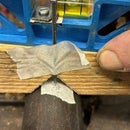Introduction: Oven Timer Problem
This is our kitchen, sort of. The house was built in the 1960's. The built-in range, range hood, and oven were the original installation from when the house was built. After forty years, the old clock dial oven timer stopped working. My wife considers an oven timer essential for having a hot meal when we come home from church services on Sunday. But, when I went to an appliance parts supplier, he informed me that timer is no longer available. He knew of no substitutes. We either needed an alternative plan or we would be spending $2,000 US for a new oven, range, and range hood.
Step 1: My Plan
I decided to run our old oven from a common timer. I chose a digital timer from Radio Shack with a seven day program and multiple event capability. A common timer like this one shown here is sold everywhere and used to control lights when people are away. It would have worked nicely, too. This one is programmed with insertable cams (red and green here) reliable to the nearest 15 minutes. My digital timer was accurate to the minute. With both styles of timer, the timer plugs into a 120 volt wall receptacle. The device to be controlled plugs into the side or bottom of the timer.
Step 2: The Mechanics of It
I planned to plug a wall wart (120 volt AC to 12 volt DC power adapter) from something we no longer used into the timer. The 12 volt current would control a relay actuated by 12 volts, but able to switch "on" and "off" a 120 or 240 volt circuit.
The graphic shows a pictorial explanation of how a relay works. A coil of wire (copper colored) is wrapped around a steel core. When 12 volts is supplied to this coil, it magnetizes the steel core. A springy piece of metal (black line) over the top of the coil is pulled toward the coil. A contact point on this piece of springy metal is pulled against another contact point and closes a secondary circuit. When current in the coil ceases to flow, the magnetism ceases and the contact points open.
The graphic shows a pictorial explanation of how a relay works. A coil of wire (copper colored) is wrapped around a steel core. When 12 volts is supplied to this coil, it magnetizes the steel core. A springy piece of metal (black line) over the top of the coil is pulled toward the coil. A contact point on this piece of springy metal is pulled against another contact point and closes a secondary circuit. When current in the coil ceases to flow, the magnetism ceases and the contact points open.
Step 3: Connections in the Old Oven Timer
It has been a few years since I did this project, but as I remember, the old timer connections appeared much as in this graphic. I disconnected the solid red pair of wires (not the wires with the blue intermittent banding) and added to their length so I could mount the relay with its plastic case far away from the oven heat. I left the old timer in place. The clock actually still told accurate time, even though it would no longer switch the oven "on" and "off."
Step 4: The Layout
This is the physical layout of the various parts. From left to right, you see the timer I used in place of the original oven timer. It plugs into a receptacle anywhere in the vicinity of the oven. It can be an outlet that is not really in view so that the timer and power adapter (wall wart) do not need to be seen. You can even hide them in a cupboard and run a white extension cord to them.
The wall wart plugs into the side of the timer you bought.
The great thing about this timer arrangement is that the wire connecting the wall wart to the relay can be clear speaker wire. It can be a very light gage so it is practically invisible. I drilled a hole in the bottom of the cabinets near the wall and ran most of it inside the cabinets where it was out of sight.
I mounted the relay inside a cabinet above the oven. It was far away from the heat of the oven. I extended the leads switched by the old timer and ran them in a corner of the cabinet where they were out of the way.
In the end, this replacement timer was a good solution to an otherwise difficult problem.
The wall wart plugs into the side of the timer you bought.
The great thing about this timer arrangement is that the wire connecting the wall wart to the relay can be clear speaker wire. It can be a very light gage so it is practically invisible. I drilled a hole in the bottom of the cabinets near the wall and ran most of it inside the cabinets where it was out of sight.
I mounted the relay inside a cabinet above the oven. It was far away from the heat of the oven. I extended the leads switched by the old timer and ran them in a corner of the cabinet where they were out of the way.
In the end, this replacement timer was a good solution to an otherwise difficult problem.






